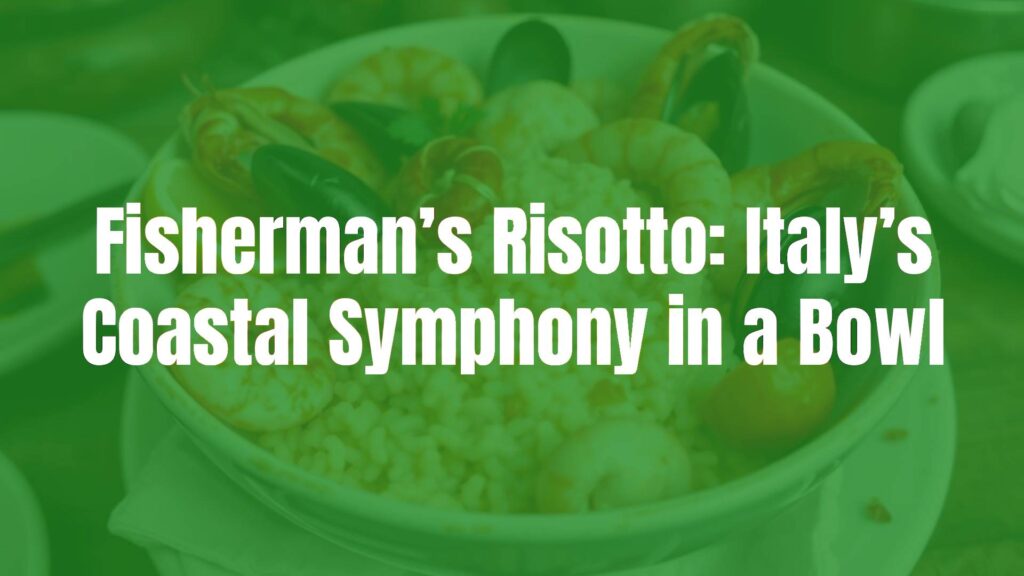Exploring Fisherman’s Risotto (Risotto alla Pescatora)
Fisherman’s Risotto, known in Italy as Risotto alla Pescatora, is a beloved seafood rice dish that channels the spirit of Italy’s seaside regions. Characterized by its use of the day’s freshest catch, this risotto is a vibrant representation of maritime tradition and culinary ingenuity. It showcases the delicate interaction between the creamy starch of rice and the ocean’s bounty, resulting in a dish that is both comforting and elegant.
The Essence and Flavors of Fisherman’s Risotto
What sets Fisherman’s Risotto apart is its harmonious blend of the sea’s flavors with the unmistakable creaminess of Italian risotto. Typically, calamari, mussels, clams, shrimp, and sometimes chunks of delicate white fish are gently cooked with carnaroli or arborio rice. The grains, slow-cooked and enriched with fish stock and a splash of white wine, absorb the essence of the seafood, producing a richly aromatic and subtly briny profile. The final texture is meant to be slightly loose and creamy, enveloping each piece of seafood in a velvety embrace.
Historical Background and Regional Context
Risotto alla Pescatora has deep roots along Italy’s coastlines, especially in regions such as Liguria, Campania, and the Veneto. While risotto originated in the rice-growing regions of northern Italy, the fisherman’s version became a popular way for coastal communities to make use of leftover catches—shellfish, mollusks, and small fish that didn’t command high market prices. Over generations, this humble dish evolved into a regional specialty celebrated in seaside trattorias and festive family meals.
Key Ingredients and Preparation Style
The backbone of Fisherman’s Risotto is, of course, quality seafood. Commonly included are fresh mussels, clams, squid or cuttlefish, prawns, and pieces of white fish, although the exact combination varies by locale and season. Essential risotto rice varieties such as arborio or carnaroli are used for their ability to absorb liquids while retaining a pleasant bite. Aromatics like garlic, onion, and parsley, along with a dash of white wine and homemade fish stock, provide foundational flavors. A finishing touch of fresh herbs and a drizzle of extra virgin olive oil elevate the dish’s brightness.
Variations Across Italy
Fisherman’s Risotto is a flexible dish, adapting to the day’s catch and local traditions. In Venice, cuttlefish ink may be added for dramatic color and a nuanced depth, resulting in Risotto al Nero di Seppia. Southern Italian versions might include a pinch of chili for gentle heat, or freshly diced tomatoes for a hint of acidity. Inland preparations could substitute lake fish for ocean species. When certain shellfish aren’t available, cooks often employ only squid, mussels, or even pieces of crab or lobster.
Serving Suggestions and Pairings
Traditionally served as a main course, Fisherman’s Risotto arrives at the table piping hot, often garnished with fresh parsley and lemon wedges. A light drizzle of olive oil or a swirl of butter add richness just before serving. Pairing this dish with a crisp Italian white wine such as Verdicchio, Vermentino, or Pinot Grigio complements the sea flavors and cuts through the risotto’s creamy texture. Crusty bread or a simple green salad make ideal accompaniments, rounding out a meal that celebrates both land and sea.
An Iconic Expression of the Italian Coast
Fisherman’s Risotto remains an iconic dish, encapsulating the heart of coastal Italy’s culinary landscape. Its appeal lies in the way it brings together simplicity, freshness, and tradition—qualities that have made it a staple of both home kitchens and renowned ristoranti along the Mediterranean. Whether enjoyed overlooking the Adriatic or recreated at home, Risotto alla Pescatora offers a transportive taste of Italy’s bountiful waters.

